Coding of repetitive transients by auditory cortex on Heschl's gyrus
- PMID: 19675285
- PMCID: PMC2775384
- DOI: 10.1152/jn.91346.2008
Coding of repetitive transients by auditory cortex on Heschl's gyrus
Abstract
The capacity of auditory cortex on Heschl's gyrus (HG) to encode repetitive transients was studied in human patients undergoing surgical evaluation for medically intractable epilepsy. Multicontact depth electrodes were chronically implanted in gray matter of HG. Bilaterally presented stimuli were click trains varying in rate from 4 to 200 Hz. Averaged evoked potentials (AEPs) and event-related band power (ERBP), computed from responses at each of 14 recording sites, identified two auditory fields. A core field, which occupies posteromedial HG, was characterized by a robust polyphasic AEP on which could be superimposed a frequency following response (FFR). The FFR was prominent at click rates below approximately 50 Hz, decreased rapidly as click rate was increased, but could reliably be detected at click rates as high as 200 Hz. These data are strikingly similar to those obtained by others in the monkey under essentially the same stimulus conditions, indicating that mechanisms underlying temporal processing in the auditory core may be highly conserved across primate species. ERBP, which reflects increases or decreases of both phase-locked and non-phase-locked power within given frequency bands, showed stimulus-related increases in gamma band frequencies as high as 250 Hz. The AEPs recorded in a belt field anterolateral to the core were typically of low amplitude, showing little or no evidence of short-latency waves or an FFR, even at the lowest click rates used. The non-phase-locked component of the response extracted from the ERBP showed a robust, long-latency response occurring here in response to the highest click rates in the series.
Figures

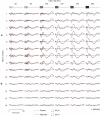



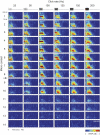
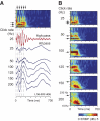
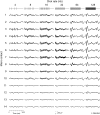
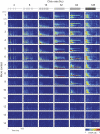
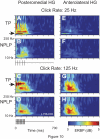

Similar articles
-
Coding of repetitive transients by auditory cortex on posterolateral superior temporal gyrus in humans: an intracranial electrophysiology study.J Neurophysiol. 2013 Mar;109(5):1283-95. doi: 10.1152/jn.00718.2012. Epub 2012 Dec 12. J Neurophysiol. 2013. PMID: 23236002 Free PMC article.
-
Functional localization of auditory cortical fields of human: click-train stimulation.Hear Res. 2008 Apr;238(1-2):12-24. doi: 10.1016/j.heares.2007.11.012. Epub 2007 Dec 8. Hear Res. 2008. PMID: 18207680 Free PMC article.
-
Electrocorticographic delineation of human auditory cortical fields based on effects of propofol anesthesia.Neuroimage. 2017 May 15;152:78-93. doi: 10.1016/j.neuroimage.2017.02.061. Epub 2017 Feb 27. Neuroimage. 2017. PMID: 28254512 Free PMC article.
-
Stimulus-dependent activations and attention-related modulations in the auditory cortex: a meta-analysis of fMRI studies.Hear Res. 2014 Jan;307:29-41. doi: 10.1016/j.heares.2013.08.001. Epub 2013 Aug 11. Hear Res. 2014. PMID: 23938208 Review.
-
Representation of temporal sound features in the human auditory cortex.Rev Neurosci. 2011;22(2):187-203. doi: 10.1515/RNS.2011.016. Rev Neurosci. 2011. PMID: 21476940 Review.
Cited by
-
Mapping human pitch representation in a distributed system using depth-electrode recordings and modeling.J Neurosci. 2012 Sep 26;32(39):13348-51. doi: 10.1523/JNEUROSCI.3812-12.2012. J Neurosci. 2012. PMID: 23015425 Free PMC article. Review.
-
Time-locked auditory cortical responses in the high-gamma band: A window into primary auditory cortex.Front Neurosci. 2022 Dec 8;16:1075369. doi: 10.3389/fnins.2022.1075369. eCollection 2022. Front Neurosci. 2022. PMID: 36570848 Free PMC article.
-
Modulation of electrocortical brain activity by attention in individuals with and without tinnitus.Neural Plast. 2014;2014:127824. doi: 10.1155/2014/127824. Epub 2014 Jun 12. Neural Plast. 2014. PMID: 25024849 Free PMC article.
-
Sparse Spectro-Temporal Receptive Fields Based on Multi-Unit and High-Gamma Responses in Human Auditory Cortex.PLoS One. 2015 Sep 14;10(9):e0137915. doi: 10.1371/journal.pone.0137915. eCollection 2015. PLoS One. 2015. PMID: 26367010 Free PMC article.
-
Using speech and electrocorticography to map human auditory cortex.Annu Int Conf IEEE Eng Med Biol Soc. 2014;2014:6798-801. doi: 10.1109/EMBC.2014.6945189. Annu Int Conf IEEE Eng Med Biol Soc. 2014. PMID: 25571557 Free PMC article.
References
-
- Bailey P, Bonin G. The Isocortex of Man Urbana, IL: University of Illinois Press, 1951, p. 1–301
-
- Bendor D, Wang X. Differential neural coding of acoustic flutter within primate auditory cortex. Nat Neurosci 10: 763–771, 2007 - PubMed
Publication types
MeSH terms
Grants and funding
LinkOut - more resources
Full Text Sources
Other Literature Sources

